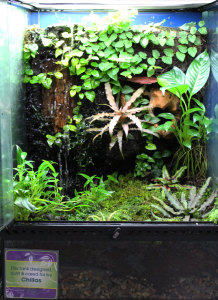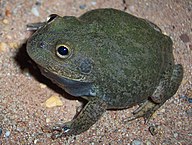In the Reptile Room section of our Lancaster, Pennsylvania retail store, our expert staff is always creating new and exciting displays. These amazing displays rarely get the exposure they deserve – so we wanted to take a moment and highlight their extraordinary work on That Reptile Blog. Check them out below or stop by our store and see for yourself!
Mantella Tank
This display features the unique Mantella frog (Mantella ebenaui) in a 40 gallon Marineland Perfecto aquarium. The brown variety of this rare frog is native to Madagascar. The landscape includes river rock gravel, topped with several live plants, including creeping fig, liverwort and begonia. The staff has also included a mini water reservoir with several small goldfish.
What makes this set up special, is that the tank is fully sustaining ecosystem that requires no filtration and little maintenance. The system relies on the live plants and gold fish to digest nutrients created by the breakdown of uneaten food and waste. The only maintenance required is feeding the Mantella and trimming back plants as needed. This set up is maintained by several members of our staff, including Josh Mangan.
 Volcano Tank
Volcano Tank
This awesome “active” volcano was handcrafted by our Reptile Room associate Jesse Taylor. The inventive design includes a Zoo Med Repti-Fogger surrounded by natural Eco Earth bedding. The fogger releases a steamy mist that creates the appearance of volcanic activity. Housed in an 18 in. x 18 in. x 24 in. Exo Terra Glass Terrarium, the ecosystem also includes an Eco Earth and live seasonal moss base, as it is prepared to hold African Reed Frogs.
 Customized Blue Gliding Frog Terrarium
Customized Blue Gliding Frog Terrarium
Created by Reptile Room supervisor Ryan Chillas, this great set up features two Vietnamese Blue Gliding Frogs. To best replicate the natural environment of the frogs, Chillas created a detailed, natural set up that includes a water reservoir and waterfall. He added a river rock base and several live plants, including creeping fig, liverwort and a peace lily.
To create the waterfall, Chillas borrowed some non-toxic expanding foam sealant from our pond section. He used it to fashion a back wall that holds an Aquatop fountain pump. The pump draws water from the bottom reservoir and moves it to the top of the foam wall. Chillas also added petrified wood and rocks throughout the foam wall. Adding live plants, it creates the perfect climbing environment that the arboreal Blue Gliding Frogs would find in their natural habitat.
If you’d like to check out these great displays, stop by our Reptile Room in our Lancaster, Pennsylvania store. In addition to these animals, we also have a large variety of lizards, tortoises and spiders to pique your curiosity. You can check with Josh, Jesse or Ryan in person or speak with any of the members of our helpful expert staff. We are always ready, willing and able to answer any questions you might have!
 That Reptile Blog – Reptile, Amphibian and Exotic Pet Care and Information
That Reptile Blog – Reptile, Amphibian and Exotic Pet Care and Information

















